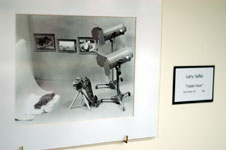Competition encourages locals to snap timeless photographs

Photospiva, the current exhibit at the George A. Spiva Center for the Arts, includes photos of every form including film, digital, scanned and photos manipulated in Photoshop.
Though anybody can snap a picture; a camera in the hands of the right person can communicate feelings, beauty, and the unseen to all who view the resulting print.
Photospiva is a competition aimed at collecting those images which best represent photography as a form of art.
The contest, which started in 1977, is the longest continuous running national photography competition in the United States.
This year, the competition saw 550 pieces entered from 117 photographers in 25 states, said Jo Mueller, director at Spiva Center for the Arts.
Unlike other photography competitions, which judge from entries on slides, Photospiva judges from actual display-ready prints.
“It’s a very exciting competition because it’s open to both professionals and amateurs alike,” Mueller said, “so the juror must be sensitive to both ends of the spectrum.”
The amateur entrants are traditionally enthusiastic and experimental, and the professionals can turn out good ideas quickly, she said.
“It’s not limited to any process – 35mm to digital to scanned and manipulated in Photoshop,” Mueller said.
The single juror for this year’s competition was Dr. Therese Mulligan, a former curator of photography at the George Eastman House.
In Mulligan’s juror’s statement, she writes, “I am, along with the public, presented with a type of ‘snapshot’ view of current issues and practices in contemporary photography.”
Though entries were received from 25 states, several residents in the Joplin area had work that chosen for the exhibition.
Bill Perry, a Joplin attorney, was one of those chosen for the exhibition. He began to experiment with photography six years ago through a class at Franklin Tech and taught himself since then.
“It’s gotten to be more than a hobby,” Perry said. “I have a gallery in Tulsa that shows my work, and I try to sell it whenever I can.”
Perry does all of his own developing and printing by hand in his home darkroom located in his garage.
“I used to have a garage,” he said. “I don’t have a garage anymore. It takes a lot of space.”
Perry is mostly involved with portraiture and figure photography.
“It’s like letting others see what I see in the beauty and mystery of the portrait and figure,” he said. “There’s so much out there for someone who’s willing to learn.”
Your donation will support the student journalists of Missouri Southern State University. Your contribution will allow us to purchase equipment and cover our annual website hosting costs.



























